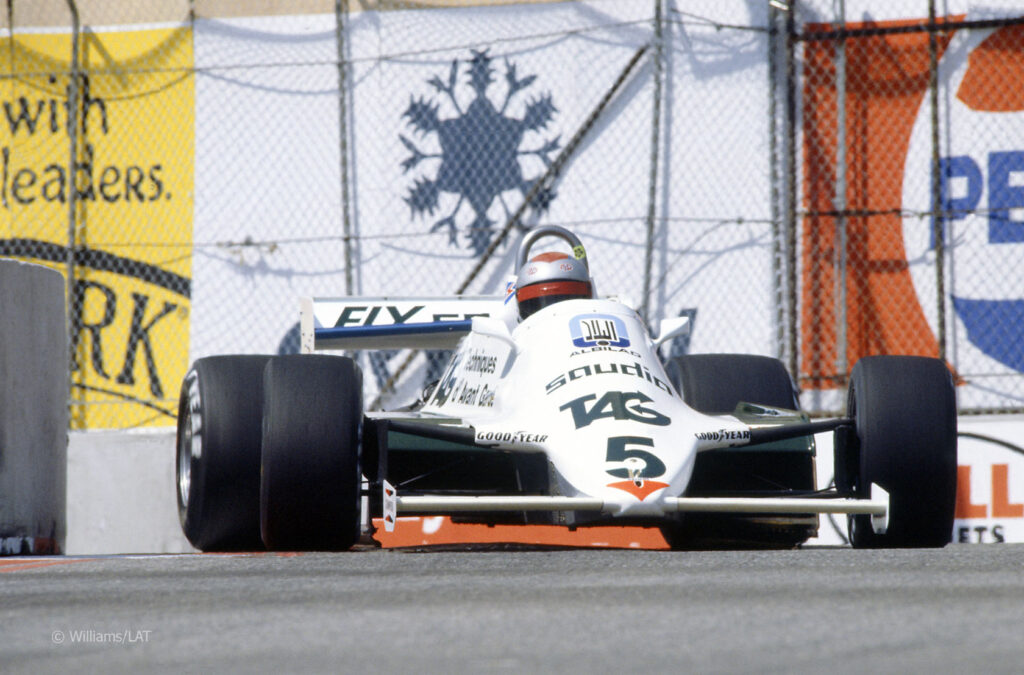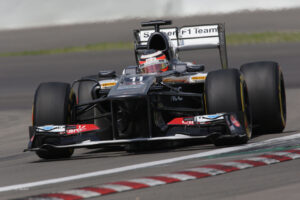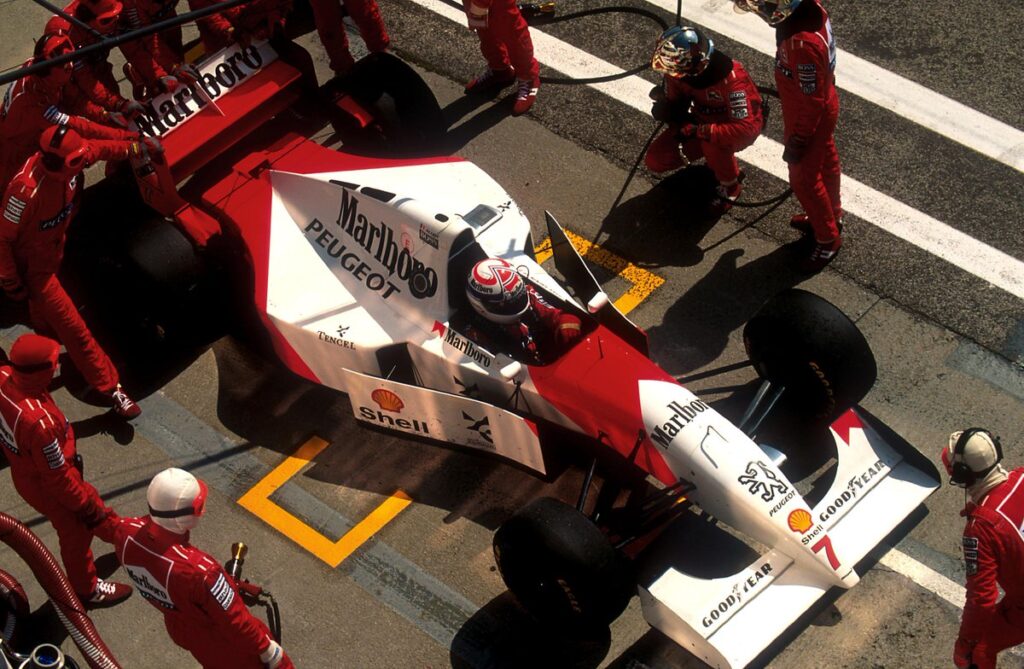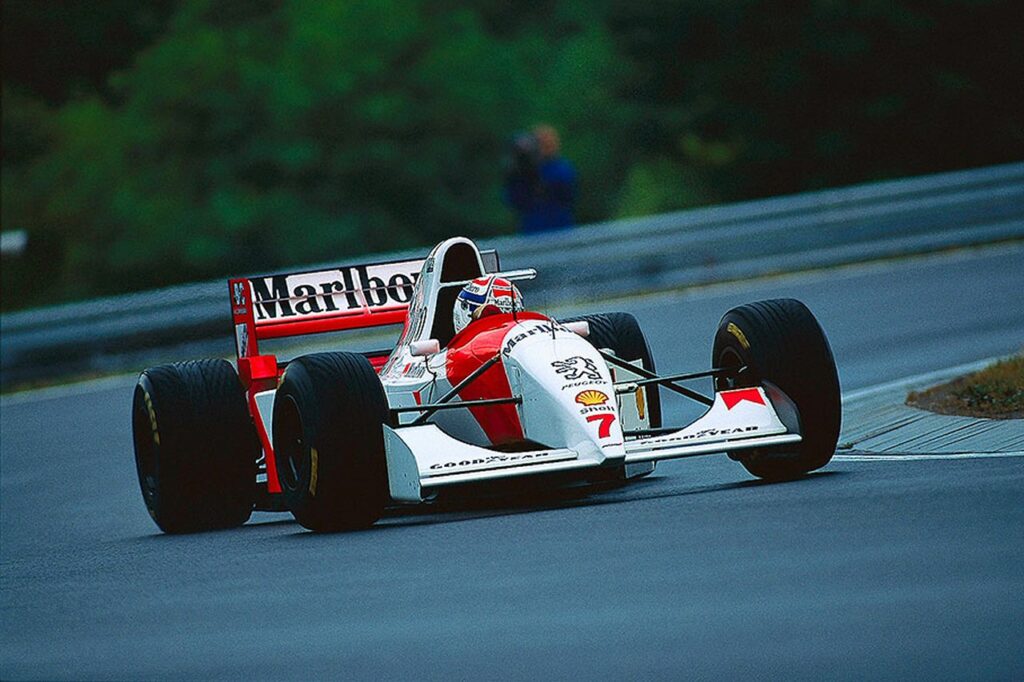TEN F1 driver/team combos you probably forgot
List Article | PetroliciousCo
Michael Schumacher and Ferrari. Jim Clark and Lotus. Jackie Stewart and Tyrrell. There are innumerable driver-team combinations in F1 that go together like rama lama lama ka dinga da dinga dong (sorry). And then there are others that make you go, ‘wait, what, really?’ These are just a handful of the latter.
Originally posted – 29 October, 2019 | PetroliciousCo (HERE and HERE)
Honourable mentions
- Gilles Villeneuve and McLaren (1977)
- James Hunt and Wolf (1979)
- Jacques Villeneuve and Renault (2004)
- Haas F1 and Esteban Gutiérrez (2016)
I mean, pretty much everyone remembers that Gilles Villeneuve began his F1 career with McLaren, right? And that James Hunt walked away from F1 after a piss-poor part-season with Wolf Racing? Do we really need to flesh these ones out?
All clear? Cool, on with the show.
1. Nelson Piquet and McLaren (1978)
-
Notable team(s): Brabham 1979-1985; Williams, 1986-1987
‘He was one of F1’s most decorated champions. Why was Nelson Piquet never signed by McLaren?’
Well, he was. Sort of.
According to a Sky Sport’s interview with four-time World Champion Alain Prost in 2013, the ’88 McLaren seat that eventually went to Ayrton Senna was originally earmarked for Piquet, given the Brazilian’s ’87 championship-winning run, his toxic relationship with then-Williams teammate Nigel Mansell, and suitable favour from Honda. None came to pass of course, and while Senna set F1’s record books – and, on occasion, his reputation – ablaze with McLaren, Piquet moved to Lotus for ’88 and ’89 before sealing his final three GP wins with Benetton in ’90 and ’91.
Interestingly though, ’88 was not the first time McLaren and Nelson Piqet had crossed paths. Following a one-off maiden run with Ensign at the German Grand Prix in 1978, the future three-time World Champion spent the next three races running a McLaren M23 entered by independents, BS Fabrications. Two DNFs and an 8th at Italy didn’t exactly scream world championship winning-pedigree, but Brabham team owner Bernie Ecclestone had seen enough to offer the young Brazilian a season contract for 1979.
Two years later, Piquet was World Champion. And it wouldn’t have been possible without McLaren. Sort of.
2. Mario Andretti and Williams (1982)
-
Notable team(s): Lotus, 1968-1969, 1976-1980; Ferrari, 1971-1972, 1982
Don’t let the Constructors’ Championship trophy fool you, 1982 was not a good year for Ferrari. The whole FISA vs. FOCA saga (we haven’t got room to run through the entire thing here so we’ll come back to it another time) led to all but 14 cars boycotting that year’s San Marino Grand Prix, a move that, ironically, helped produce one of the sport’s most famous on-track duels between Ferrari teammates Gilles Villeneuve and Didier Pironi. Unfortunately, the fallout from THAT indirectly led to the former’s death on-track at Zandvoort two weeks later, and the latter’s career-ending shunt in the wet at Hockenheim that August. While the Frenchman was leading the championship. Acute back pain even side-lined substitute Patrick Tambay at Dijon. Seriously, ’82 was not a good year for Ferrari.
The Italian-born American that helped drag the Scuderia out of the doldrums? 1978 champion and all-round motorsport badass Mario Andretti, who donned scarlet for the final two rounds of the season and took a memorable pole position on his first start with Ferrari in over 10 years. And at sodding Monza, no less! An eventual 3rd was the cherry atop a very emotional cake.
What many Ferrari fans would like you to forget though was that this two-race run weren’t the only F1 starts for Andretti that year. The then-IndyCar championship contender had actually made his GP return six months earlier as a one-off favour for Williams following the shock retirement of Carlos Reutemann. Long Beach ’82 won’t be making Mario’s highlight reel unfortunately, the American great qualifying a disappointing 14th before retiring from the race after hitting the wall on lap 18.
3. Marcus Ericsson and Caterham F1 Team (2014) Or… Brawn GP?! (2009)
-
Notable team(s): Sauber/Alfa Romeo, 2015 to present
Well, this seems timely, given that American powerhouse Chip Ganassi Racing has just signed the Swedish racer to drive a third car in the 2020 IndyCar season. A return to Formula 1 racing and another start to an impressive 95 Grand Prix tally seems unlikely any time soon then, despite Marc Ericsson continuing his third driver role with Alfa Romeo Racing (formerly Sauber), a team he has been part of since 2015.
Contrary to popular belief though, it’s not where the Swedish racer’s F1 tenure began, and chances are you’ve forgotten Ericsson’s debut F1 season with the equally forgettable Caterham F1 Team in 2014. Though there were flashes of speed, the deficiency of Caterham’s CT05 swansong meant points were never a consideration, and Ericsson’s finished his season early with a best finish of 11th at Monaco.
So, why is the IndyCar rookie on the list? Well, ironically – or brutally – while Ericsson’s part-season in the Caterham is rarely talked about, his teammate for that year’s Belgian Grand Prix is, given that it was a one-off F1 entry for three-time Le Mans winner, André Lotterer.
Still not buying it? Then how about this: Marcus Ericsson was the last driver to ever complete an official F1 practice session for 2009 World Champions, Brawn GP, with the title-winning BGP001 no less, before the team morphed into Mercedes GP for 2010.
4. Sebastian Vettel and BMW Sauber (2007)
-
Notable team(s): Red Bull Racing, 2009 to 2014; Ferrari 2015 to present
This may smack of hypocrisy given our ‘Honourable mentions’, but given that this was a one-race deal AND set two Formula 1 records in the process, we felt it warranted inclusion.
An official BMW test driver for 2007, a young Sebastian Vettel received his F1 call-up for that year’s United States Grand Prix at Indianapolis, following a high speed accident for regular driver Robert Kubica at the previous round in Canada. A solid run it was too, the future four-time F1 champion setting the fourth fastest time in free practice, qualifying 7th and finishing 8th to collect his first (of so many) World Championship points. Red Bull Racing, sufficiently impressed with its young driver development protégé, drafted Vettel into the Toro Rosso seat of a vacating Scott Speed four rounds later in Hungary, and just one year later, the young German collected a remarkable maiden win for the former Minardi team in the downpour at Monza. A record-breaking run with Red Bull Racing awaited.
As for his BMW race debut, young Master Vettel was 19 years, 349 days old when he scored his first F1 point, the youngest in history to do so at the time. His other record from that weekend, which will probably survive intact, is the fine he received for speeding in the pit lane…SIX seconds into his Grand Prix career.
5. Alan Jones and Arrows (1983)
-
Notable team(s): Williams, 1978-1981; Team Haas, 1985-1986
Bored of the travel and a critic of the runaway train that was ground effect, Williams’ first F1 World Champion Alan Jones left the F1 paddock seemingly for good at the end of 1981 in favour of an Australian GT Championship – every round of which he won – and his 2,200-acre cattle farm in Melbourne for 1982. Until boredom struck.
Having missed the Ferrari call-up that eventually went to Mario Andretti for Monza ’82 (see above), Jones famously made his F1 return in 1986 with the original Team Haas USA, competitive spark seemingly relit. One that was summarily beaten to death by a woefully unreliable turbo Ford V6.
What people tend to forget though is that Haas wasn’t the first team to coax the ’80 World Champion out of retirement. Like Mario Andretti before him, Jones’ original GP return was an official one-off run at Long Beach, and in the Aussie’s case, it was for Arrows in 1983. It went as well as you’d imagine. “Too many barbies and Fosters Lager” by his own admission, plus a broken femur caused while horseback riding, meant the former Williams man was completely knackered by lap 58 and unable to complete the remaining 55km. A promised big money sponsor failed to materialise and Jones had just one more run in the Arrows A6 before disappearing back to Melbourne.
6. Nico Hulkenberg and Sauber (2013)
-
Notable teams: Force India, 2011-2012, 2014-2016; Renault, 2017-2019
The German star looks set to miss out on an F1 driver for next year, with Mercedes’ former protégé Esteban Ocon taking his place at Renault for 2020 and Antonio Giovanazzi looking comfortable at Alfa Romeo with Ferrari’s parental hand resting on the Italian’s shoulder. So if anything, this entry feels timely.
Should voodoo turn out to be real though, and Hulkenberg ends up benching Giovanazzi at Alfa Romeo, this would mark the 2015 Le Mans winner’s second season with the Hinwil-based outfit following a solid if fruitless run in 2013. An unofficial Ferrari ‘b-team’ at the time given its use of Maranello V8s, talk had been rife that Hulkenberg would join the Scuderia in 2013 to replace a vacating Felipe Massa, only for the Brazilian to re-sign a one-year deal at the last minute.
Ah well, no harm done. A race seat at Ferrari alongside Fernando Alonso surely awaited ‘the Hulk’ for 2014, especially with a year at prancing horse-powered Sauber under his racing belt. Unfortunately, the resurgent form of former Ferrari World Champion Kimi Raikkonen meant the Finn was Maranello-bound for 2014, firmly slamming the door in Hulkenberg’s face in the process. Instead, the German was on his way back to Force India for 2014, keen to sweep the missed Ferrari opportunity and his single year with Sauber under the rug.
7. Keke Rosberg / Fittipaldi
-
Notable teams: Williams, 1982-1985; McLaren, 1986
One combo we could have put on this list but felt deserved better was Emerson Fittipaldi’s catastrophic decision to leave McLaren in 1975 and join the family F1 team founded by elder brother, Wilson. His seasons driving for ‘Fittipaldi’ / Copersucar produced just two podium finishes and 37 points in total, less than he’d scored in ’75 alone! Mercifully, though he’d dropkicked most of his credibility to death during those five seasons, Emerson Fittipaldi rejuvenated most of it with two Indy 500 wins and an ’89 IndyCar championship.
What people tend to forget about the Copersucar debacle is that, for his final season in 1980, Fittipaldi was teamed with moustachioed Marlboro enthusiast, Keke Rosberg. The future World Champion, who already replaced outgoing ’76 champion James Hunt at Wolf the year before, made a quick impression, finishing 3rd on his Fittipaldi debut in Argentina. The Finn scored only two more points thereafter, but his pace was enough to catch the eye of Williams, with which he’d forge his F1 legacy from 1982 onwards.
That year, Rosberg took his first win, and thanks to the FISA-FOCA fallout and a tragically bad year for Ferrari, won the world title in his maiden year with Williams. In 1986, he set an average lap speed record – 160.9mph / 258.9 kph – that stood untouched for 16 years, and signed off his Williams career in style with his final Grand Prix win. A swansong year with McLaren awaited, the ’82 champion signing off in Australian with his Fittipaldi days firmly behind him.
8. Daniel Ricciardo and HRT (2011)
-
Notable teams: Red Bull Racing, 2014-2018; Renault, 2019
So entrenched is Toro Rosso as the F1 starting point for Red Bull Racing’s young driver program these days, many forget that one of the Austrian conglomerate’s most successful chargers actually made his F1 debut with another team. To put that into perspective, of the 14 drivers to have raced for Toro Rosso, only three debuted with a different team.
Rewind to 2011, and The Honey Badger, already a Toro Rosso third driver, was halfway through a challenge for that year’s Formula Renault 3.5 Series championship when the call came through. Ricciardo would replace the outgoing Narain Karthikeyan at HRT for that year’s British Grand Prix. Ironically, his new teammate was former Red Bull / Toro Rosso driver, Vintantonio Liuzzi (and that’s make three).
Though he didn’t score any points, Ricciardo finished all but his debut ahead of Liuzzi, and having interlaced both campaigns, even managed to claim 4th in the Formula 3.5 standings, despite missing the final round. One year later, Ricciardo’s Toro Rosso career had begun, leading to a prolonged stint at Red Bull Racing in which the Aussie showed his formidable chops against four-time World Champion Sebastien Vettel and later against new wunderkind, Max Verstappen. Seven Grand Prix wins later and with a new life at Renault already underway, Ricciardo’s 11-race stint with the now defunct HRT is long forgotten.
9. Martin Brundle and Williams (1988)
-
Notable teams: Tyrrell 1984-1986; Benetton 1992; McLaren 1994; Jordan 1996
Before he found renewed life behind the mike, Martin Brundle’s F1 career was very much a case of ‘wrong place, wrong time’. The ‘88 World Sportscar Champion’s sole season with the multi-title winning McLaren in 1994 coincided with the team’s one-year use of the woefully unreliable Peugeot V10, and his two podiums to Mika Hakkinen’s six didn’t help.
Two years earlier, Brundle had his first season with a front-line Grand Prix winner in Benetton, only for his teammate to end up being future seven-time World Champion, Michael Schumacher. His giant-killing performances in his debut year with Tyrrell came to naught when the team was summarily disqualified from the 1984 season. Even his barrel roll in the ’96 Jordan in Melbourne is regularly brought up.
Hidden amidst those conspicuous years is a single ‘87 season with Zakspeed – who? – and a one-off run for Williams at Belgium in 1988. The Briton deputised for the reigning World Champions when team leader Nigel Mansell was side-lined with chicken pox. Naturally, given Brundle’s luck, this was also the year in which Williams used the pathetically underpowered Judd V8 before its almost sarcastically successful switch to Renault power, meaning Brundle could only manage 7th, one lap down.
Brutally, even the Briton’s one-off replacement – Jean-Loius Schlesser – wrote himself into the history books one race later at Monza when he punted Ayrton Senna out of an easy race win at Monza.
10. Philip Alliott and McLaren (1994)
-
Notable teams: …er…
Yep, this one definitely stands out for Woking. Like Derek Bell, Jacky Ickx and – good grief – Gilles Villeneuve before him, Philippe Alliot’s McLaren tenure was a one-race deal. And, unfortunately, it went poorly.
Replacing a suspended Mika Hakkinen, the admittedly amiable Frenchman qualified almost a full second behind teammate Martin Brundle at the 1994 Hungarian Grand Prix, and retired after just 21 laps.
So how did this ‘guest’ appearance come about more than 10 years after Alliot’s F1 debut? Connections mainly, as, thanks to the Frenchman’s long-standing friendship with the boss of Peugeot – who just so happened to be powering McLaren that year – he was signed as Woking’s test driver for 1994. Before that, Alliot’s F1 career amounted to seven points scored across eight uncompetitive seasons with RAM, Ligier and Larrousse, the Frenchman’s penchant for crashing an increasingly livid Guy Ligier’s cars helping to ease the door open for a two-year F1 hiatus in 1992 and 1993. Ironically, Alliot finished 3rd at Le Mans both years.
Thoughts that the perennial journeyman might replace Brundle at McLaren were almost laughably discounted after Hungarian ‘94, and the Frenchman brought his F1 career to a close at the following round in Belgium, again with Larrousse. Though he’s one of only eight drivers to start a single F1 race with McLaren in the team’s 53-year history, Philippe Alliot’s 116 starts without a podium finish also puts him 4th on the all-time record’s list. Ouch!
Images | McLaren, Williams, Marco’s Formula 1 Page, Jon Super and BMW MotorsportMcLaren, HRT/Hispania, Williams and Sauber
List Article | PetroliciousCo | James Gent




















